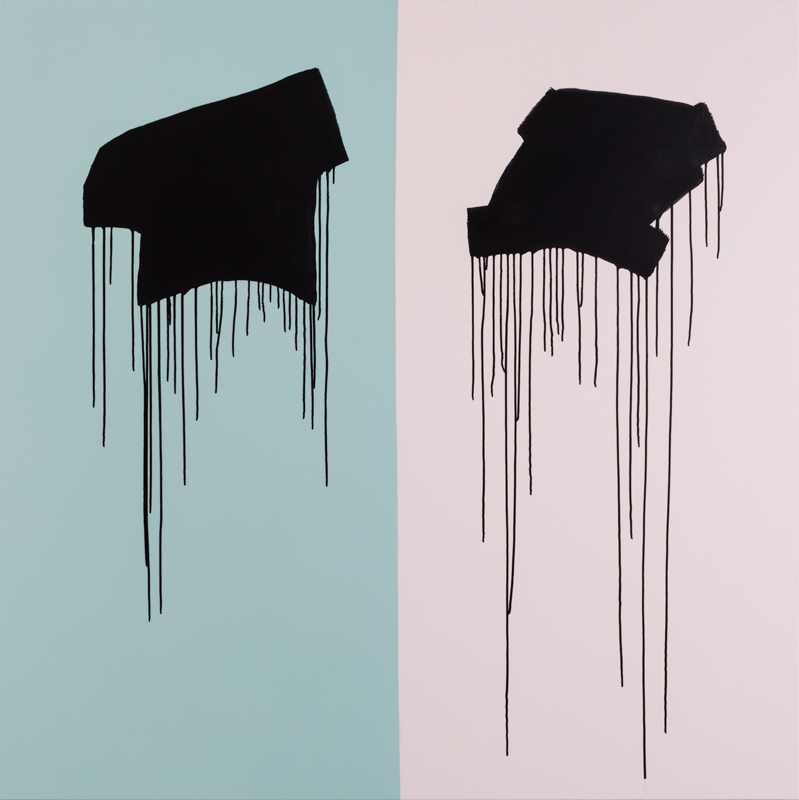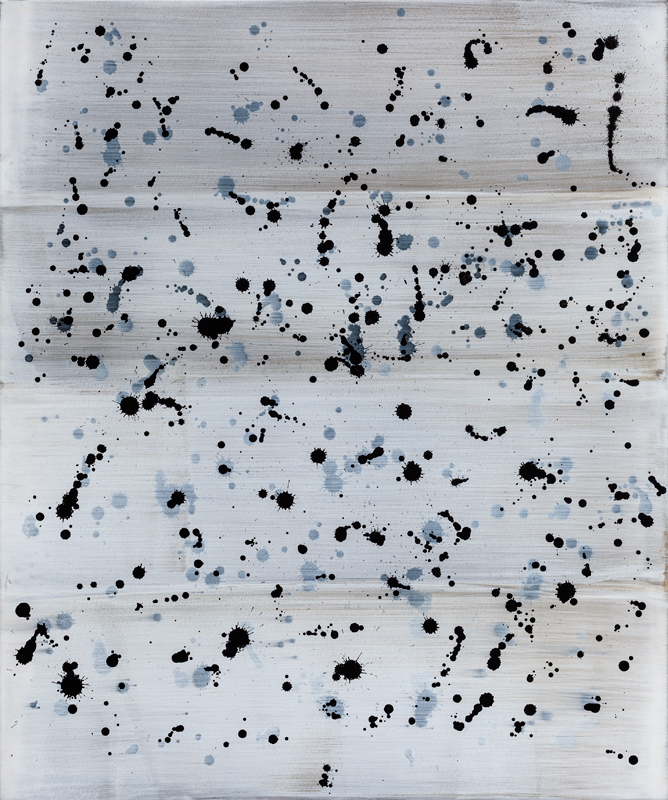30/08/16
Julie Umerle: An
Exploration of Mark-Making
An essay on the occasion of
Julie Umerle: Rewind
AB Project Space
31 August – 10 September 2016
‘First and foremost, “mark” is a product as well as a process,’ writes
Kelly Baum.1 ‘More specifically, it is an end that cannot be
separated from its means.’ Marks may issue directly from the artist’s hand, via
a brush or a palette knife in contact with the canvas, or there may be some
attempt on the part of the artist to hand over control and distance him- or
herself from the process. Even so, the resultant marks are the traces of an artist’s
action. When Jackson Pollock poured his paint directly from the can, or dripped
it from a stick, for example, his direct influence might have become less
apparent, but, nevertheless, it was still his bodily movement that
choreographed the encounter between paint and canvas. Harold Rosenberg spoke of
the abstract expressionists as producing ‘events’ rather than ‘pictures’. ‘The
painter,’ he wrote, ‘no longer approached his easel with an image in his mind;
he went up to it with material in his hand to do something to that other piece
of material in front of him. The image would be the result of this encounter.’2
For Julie Umerle, this assertion might hold in part, but, influenced by
minimalism and post-minimalism as well as the ‘new American painting’, her work
is an exploration of mark-making of many different types.

The works closest in spirit to the ‘encounter’ alluded to by Rosenberg
are those in her Transoxide series
(2015-16), built up on wet
stretched paper with a coloured ground, as a successive layering of white paint
and flicked splatters of ink. With the initial colour pulled across the sheet with
a large brush, forming a ‘grid’, the accumulated layers veil this underlying order
with their seemingly haphazard clusters. Suggestive of multiplying cells, reproducing
bacteria, or dark stars in a bright sky, there is an element of the organic,
echoed also by the splitting and cracking of the ink on the surface, varying in
degree according to the specific mixture used in each case.

These paintings are an experiment, both in
mark-making and materials, and typical of the way in which Umerle works:
progressing from one piece to the next, continuing an idea, cycling through open-ended
series, pushing boundaries and exploring elements that fascinate her along the
way. The
physicality of the medium and her attention to surface are countered, however,
by a strong compositional element within the structure of the paintings.
Drift III (2016), for example, is a reworking of an earlier piece that got
damaged. Attempting to recapture what it was she loved about the previous work,
Umerle has, nevertheless, both subtly repositioned the looming black shapes,
and, per force, submitted to the will of gravity and the pull of the paint
itself as it drips down the canvas. Here, as is also the case for Naples Orange (2013) and Buff Titanium (2013), the drips result
directly from the pressure of the brush as it is swept across the softly
coloured, divided ground – an interesting contrast in terms of direct contact
to the remote mark-making of the Transoxide
series’ flicking approach, treading that fine line between directing what you
want the paint to do and letting it do its own thing; between precision and
chance.

The Rewind series (2014-16) sets out to
isolate and refine the marks from the Drift
paintings, positioning them tightly within the square frame of an unprimed
canvas, exploiting the pictorial space to the max. With the omission of the
drips, the process is obliterated, and the mark-making becomes defined instead by
technique. Similarly, the loss of action asserts both the flat forms and the
flatness of the canvas itself. This is, as Charles Harrison termed it,
‘painterliness, freed of depicting function’.3 First in black, and
then, in the later paintings, in red, the series invites the viewer to hit the
pause button and observe in still meditation. With the black shapes, it is like
looking through space, aiming towards infinity, while, in contrast, the red
shapes appear to jump forwards, escaping the pictorial frame and entering the
viewer’s own personal space. As the ‘painter of black’, Pierre Soulages, said:
‘It’s important to experience aesthetic shock, which sets in motion our
imagination, our emotions, our feelings, and our thoughts. That’s the purpose
of a painting and of art in general.’4 Umerle certainly achieves
this, both by her stripping bare of these shapes – revealing the ‘nakedness’
that Robert Motherwell attributed to abstract art – and by the large scale of
many of her works, which seem to shout out to you, compelling you to stop and
look, engaging you in what Mark Rothko described as ‘an immediate transaction’,
drawing you in ‘to create a state of intimacy’.5
Early in her
career, Umerle was advised by Robert Ryman to avoid naming her works after
feelings and, indeed, she describes her feelings as being shut off when she is at
work, as she becomes engrossed in the creative process. Viewers’ responses are
always subjective, and any associations they make, be they figurative or
emotional, are entirely their own. The black Rewind triptych offers something of an enigma code, suggesting an
order in which the hieroglyphs might be read, inviting the viewer to attempt an
interpretation. Take note, however, that, as with the Holy Trinity, each of
these three entities might be more than one thing at once and, overall, no
satisfactory understanding might be attained: it is, perhaps, equally a matter
of submission and belief.

Just as
Motherwell saw his work in terms of ‘a dialectic between the conscious
(straight lines, designed shapes, weighted colours, abstract language) and the
unconscious (soft lines, obscured shapes, automatism)
resolved into a synthesis which differs as a whole from either’6, so
Umerle’s work treads a similar path, proving that formal and spontaneous
procedures are not necessarily incompatible and that mark-making truly is both
a means to an end and an end in itself.
Notes:
1. Kelly Baum, ‘Rothko to
Richter/ Mark-Making in Abstract Painting from the Collection of Preston H.
Haskell, Class of 1960.’ Essay to accompany the exhibition of
the same name at Princeton University Art Museum, 2014. Available online at:
http://artmuseum.princeton.edu/story/rothko-richter-mark-making-abstract-painting-collection-preston-h-haskell-class-1960
[Accessed 18/07/16]
2. Harold Rosenberg, ‘The American Action
Painters’, 1952, reprinted in Ellen G Landau (ed), Reading Abstract Expressionism. Context and Critique, Yale
University Press, 2005, pp189-197, p190
3. Charles Harrison, ‘Abstract Expressionism’
in Tony Richardson & Nikos Stangos (eds), Concepts of Modern Art, Penguin, 1974, pp168-210, p172
4. Zoe Stillpass, interview with Pierre
Soulages in Interview magazine,
published 05/08/14. Available online at:
http://www.interviewmagazine.com/art/pierre-soulages/#_ [Accessed 18/07/16]
5. Mark Rothko, from
excerpts from a lecture given at the Pratt Institute in 1958, noted by Dore
Ashton and published in Cimaise,
December 1958. Cited in Harrison (1974), p195
6. From a statement in Sidney Janis, Abstract and Surrealist Art in America,
New York, 1944, cited in Harrison (1974), p170
Images:
All courtesy the artist
Drift III (2016)
150 x 150cm
acrylic on canvas
Transoxide III (2015)
60 x 50 cm
aquacryl and shellac ink on wet stretched paper
Rewind III (2014)
55 x 55 cm
acrylic on unprimed canvas
Buff Titanium (2013)
135 x 150cm
acrylic on canvas